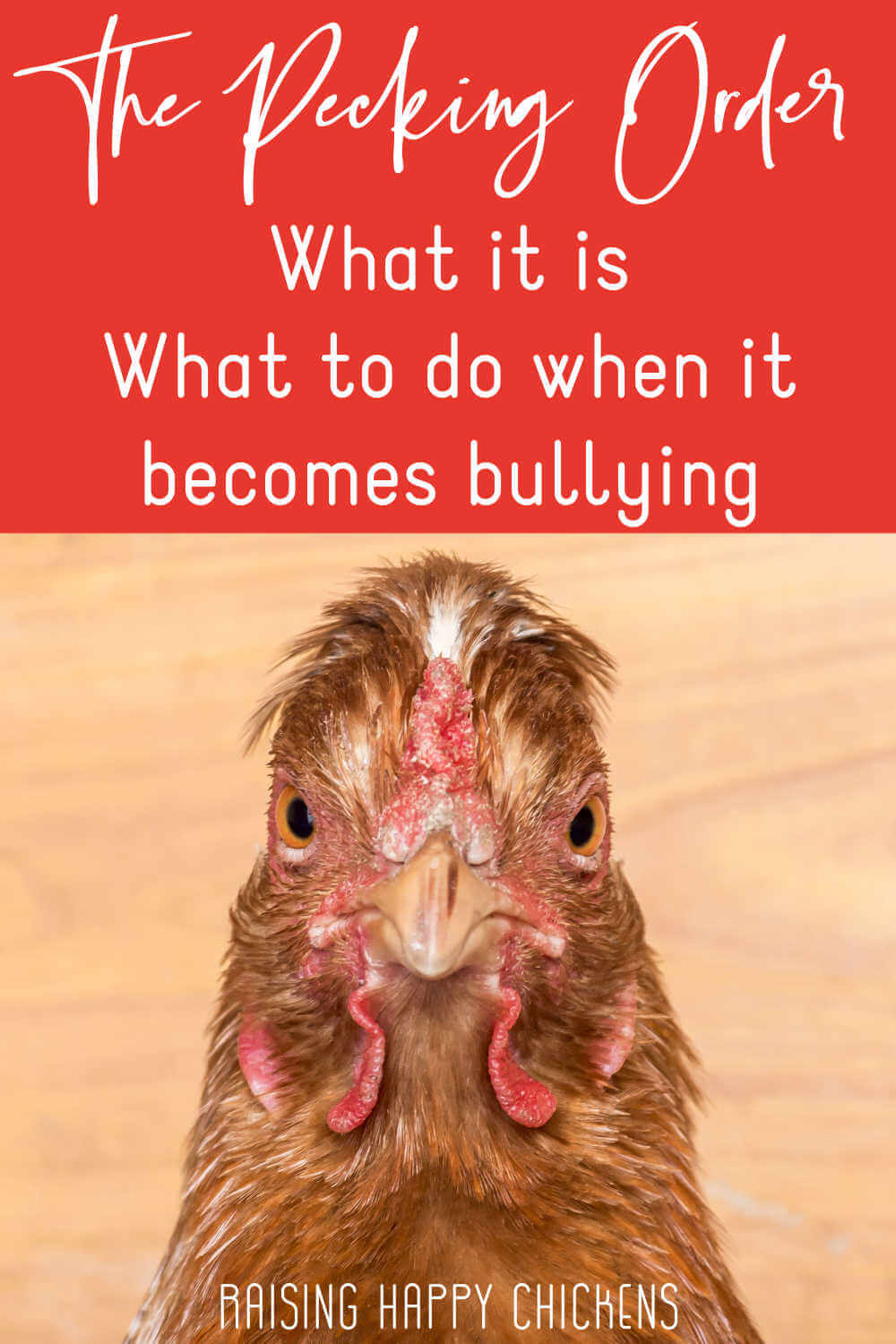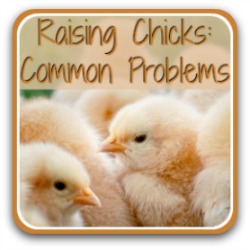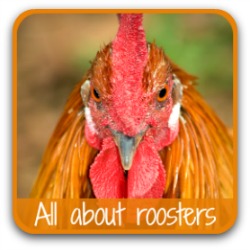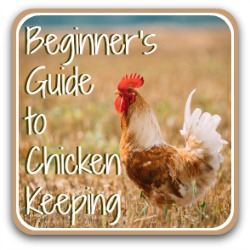- Home
- Challenges
- Pecking order
The pecking order.
What pecking order in the chickens coop means, why and when it happens and what to do when it becomes bullying.
Our ideal picture of our chickens is usually of a quietly clucking flock making their way through green pasture, collecting healthy bugs and plants on the way.
But it's not always like that. Chickens have a very strong sense of hierarchy – who should be the dominant bird in even a small flock, who deserves first place in the food queue, who gets the best place on the roost at night.
And that can sometimes cause problems.
It's called the "pecking order", and this article covers:
- what the pecking order is
- why it happens
- when it starts
- how it's worked out
- can it change?
- working out the pecking order in your flock
- how to know when it escalates from pecking order to bullying
- what to do with a chicken bullying another chicken.
Pecking order: theory and meaning.
The theory.
The pecking order was first identified back in 1922 by a Norwegian zoologist, Thorleif Schjelderup-Ebbe. He first conceived of the term "pecking order" after watching his own flock of chickens and the way they interacted. His findings were widely published in 1935(1).
Since then, it's been identified in many other species, and the name in academic research has morphed to become "dominance hierarchy".
In chicken circles, it's still known as the pecking order. It just fits.
What exactly is the "pecking order"?
It's basically quite a complex social system which will be formed in any flock of more than three chickens(2).
Some chickens – Schjelderup-Ebbe called them the "despots" – are allowed to peck everyone, and are therefore top of the pecking order. Others are ranked less high, until at the bottom of the ladder there are those who never peck, but are always the recipients of pecking.
Birds at the top of the pecking order will normally have the best of everything: food, water, treats, nest box, place on the roost, room in the dust bath, and access to the rooster or hen of choice for mating...
Others must take their place as defined by where they are in the hierarchy. Meaning that some birds can find their lives made miserable, chased from the feeder or even prevented from entering the coop.
Chickens can be ruthless.
Why do flocks always form a pecking order?
Two reasons:
- To ensure the survival of the flock (ever heard of the "survival of the fittest"?)
- To keep the flock in good order. If a squabble starts and the "head hen" (or rooster) steps in, it can prevent what starts as a bit of bickering from becoming a full-scale, and probably pretty nasty, fight.
When does the pecking order start?
Chicks and the pecking order.
If you've ever raised chicks, you'll know that fighting to establish a pecking order can start very early – research suggests as quickly as two weeks post-hatch(3).
Baby chicks are naturally curious, so it's important not to make snap judgements but to watch their behaviour. These two, for example, could be checking each other out, or spoiling for a fight.
In fact, they were just curious. There was no pecking order nastiness and they ended up being the best of friends in my coop.
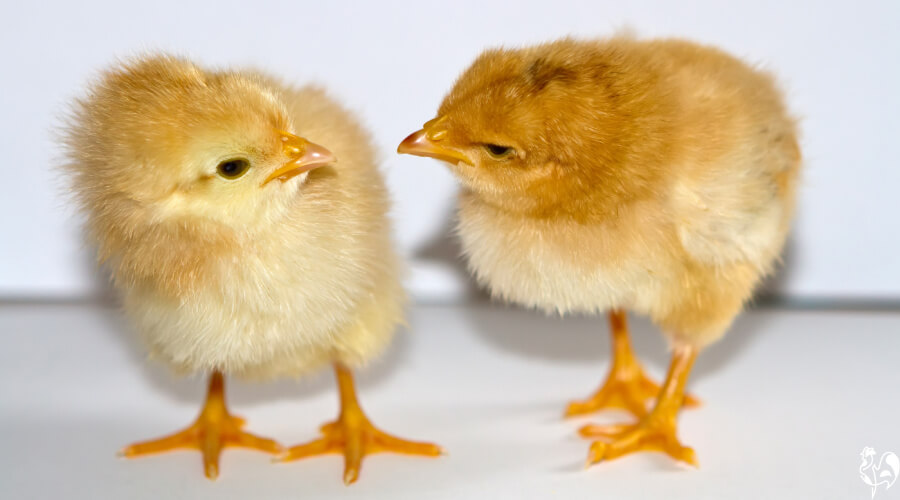
To identify pecking order behaviour you'll see chicks "charging" at each other, chasing their brooder-mates or actively and constantly pecking smaller chicks.
There's a difference between groups based on size and gender, though:
- Small groups of chicks will establish a pecking order by eight weeks post-hatch.
- Groups of all female chicks of any size will establish the pecking order by ten weeks post-hatch.
- Male chicks can take several weeks longer to work out their pecking order – sometimes well into maturity.
Adult behaviour.
- A new group of adults will establish a pecking order within days of being brought together, usually without problems after the inevitable initial squabbles.
- A group of chicks introduced to an established group of adults will take a lot longer. This requires very careful handling if the chicks are not to be killed by the adults in the established flock.
- In that case, chicks should be large enough to be able to hold their own before the two flocks are merged. In the meantime they should be kept within sight and sound of the established flock, so that the two become used to each other.
- This is one of my adult Speckled Sussex hens visiting three week old chicks in their Eglu run. The Eglu is set within the large run, so the main flock can see and hear the chicks, but the chicks are safe.
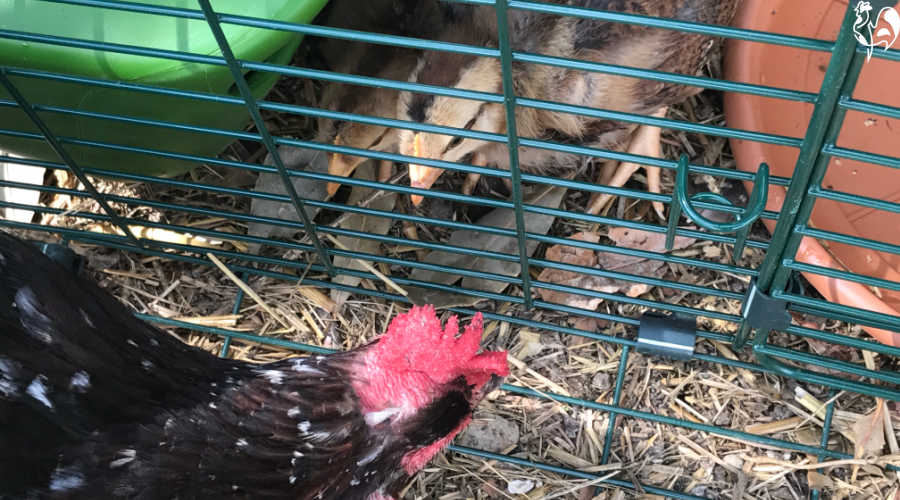
- If these two groups were mixed at this point, the pecking order could see the chicks injured or even killed.
- When they're ready, adding the newbies after they have roosted at night works well for most. They seem to accept new flock members when everyone's a bit dopey!
How is the pecking order worked out?
The key to Schjelderup-Ebbe's research was his view of chickens as individuals, not a general species(1).
He recognised that individual differences play their part in forming the flock's hierarchy. Those differences include...
- Gender (males tend to dominate, though not always – my most aggressive chicken bully ever was a Red Star hen)
- Age (older chickens tend to be higher up the pecking order, although this will change over time)
- Comb size (the bigger, the better!)
- Body weight (heavier is better as it often correlates with strength)
- Health (sick or frail chickens will be at the very bottom of the pecking order).
What do pecking order battles look like and should you intervene?
- Chickens are generally excellent at recognising who amongst them should be the dominant rooster or hen. No human intervention is necessary even when you witness short skirmishes.
- Sometimes, two birds who both consider themselves to be a good candidate for "top chicken" will compete for the job, and that can lead to what seems quite vicious pecking or full-scale fights.
- Even then, they should be allowed to sort it out between themselves. Most of these battles will be done within a few minutes.
- If it's descending into enough of a protracted battle for one or more birds to be seriously harmed, there are steps you can take – see this section.
Can the pecking order change?
It can and does(1). As with all relationships, it's a dynamic rather than static situation, so as the make-up of the flock changes, so will the pecking order.
That change can be slow, over a number of months, or very quick if a situation arises which challenges it.
Some of the known reasons for change are:
- the dominant chicken becomes old, ill or in some other way infirm
- young pullets decide they're the new kids on the block and better suited to dominate
- the dominant hen goes broody and leaves the flock for long periods
- one hen or rooster decides s/he's going to rebel and challenge the dominant bird
- a bird who has been removed from the flock for some reason is re-introduced
- a new chicken is introduced to the flock.
Mixing two flocks to reduce pecking order problems.
In the photo below, you can see my well established flock (outside the run) visiting a new group of adults. The new flock is kept in a run placed inside the main fenced run, so that both flocks can see and hear each other but not yet integrate.
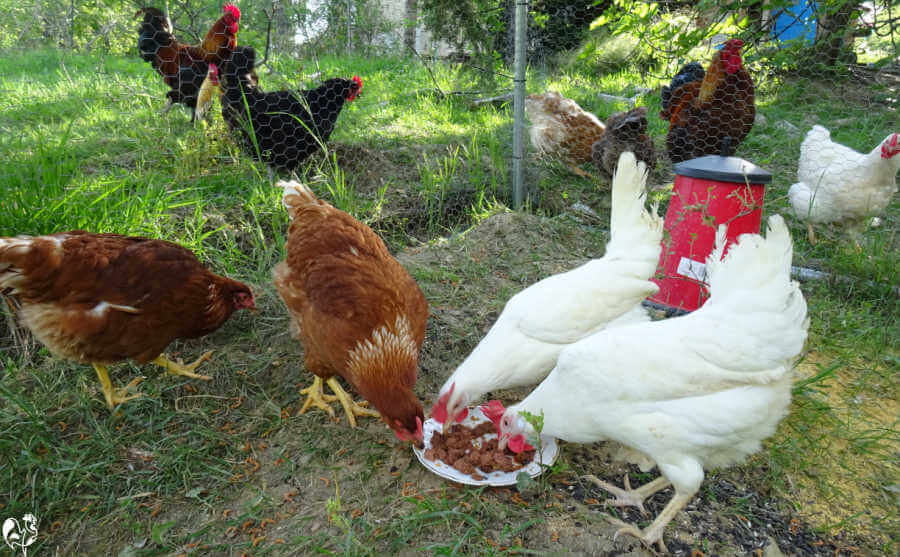
When the two groups are mingled, the pecking order is likely to change as the chickens work out where the newbies fit into the hierarchy.
The fact that the two groups have been able to get to know each other at a distance is likely to reduce the incidence of pecking order problems when they're mixed.
How to assess the pecking order in your own flock.
The best and only way to do this is, as all researchers have done, to spend time with your flock.
Having all the information about what the pecking order means and how it's formed makes watching your chickens' behaviour and the relationships between members of your flock fascinating.
Take note of who dominates and who loses out by watching who...
- does the most pecking of others in the flock, and who is always pecked
- gets to the food first – or is prevented from eating
- gets the best nest box (the one everyone wants!), or is forced to lay elsewhere
- is called for treats first by her rooster, or is always left out
- is being "over-used", or being ignored (which in this case may be preferable!)
- is first on the roost – or not allowed on the roost at all.
When the pecking order goes wrong: chicken bullying.
Managing the pecking order is a natural behaviour which should be left to the flock to sort out. You won't be able to change it, no matter how unpleasant it may seem.
However, there are times when it can descend into bullying behaviour. A full-on pecking order fight can be vicious – sometimes fatal.
Chickens who persistently bully other chickens are detrimental for the flock and need to be managed.
When and how does bullying start?
Research scientist Eli Strauss says this:
"The view that dominant animals act as benevolent leaders of their groups is wishful thinking... Individuals holding high status use their status to advance their personal interests"(4).
And in his original research, Schjelderup-Ebbe goes even further:
"The face of the despot would radiate with joy of satisfied pecking-lust and the fury could clearly be observed in its eyes".
So bullying can simply be a dominant chicken becoming a little too full of him / herself and wanting total flock domination rather than using her position to ensure the smooth running of relationships.
It can take forms other than full-on fighting though, such as...
- preventing another chicken from feeding or drinking
- isolating the victim(s) by chasing away from the rest of the flock
- keeping others out of the coop at night
- pulling feathers out
- drawing blood, particularly from the comb.
Watch for these signs within your flock. If you see any of them, it's time to act.
These two Speckled Sussex hens, bottom of the pecking order, were forced to roost in my bay tree because they were being prevented from entering the coop by a Red Star bully.
She was dealt with by isolating her from the flock until she had learned some manners.
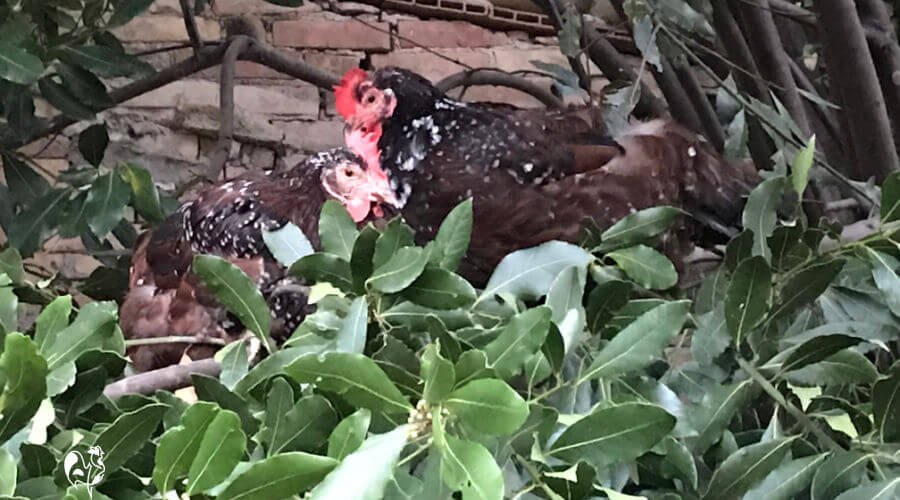
How to stop chicken bullying.
Bullying can be reduced in a number of ways, including isolating the bully. This in itself can cause problems though, so there are a number of other steps to try first.
1. Make sure your chickens have enough space both inside and outside the coop. Having insufficient space is known to lead to feather-pecking, a known symptom of bullying.
2. If possible, allow your flock to free range. As well as having individual space, being able to forage widely distracts and stimulates, so bullying becomes far less likely.
3. If free-ranging is not possible – and it's always risky – design as large a run as possible, making sure it's securely fenced.
4. If your dominant chicken is guarding feeders and waterers, other flock members will potentially die. Make sure that there are two or three different points in the run where they can access food and drink.
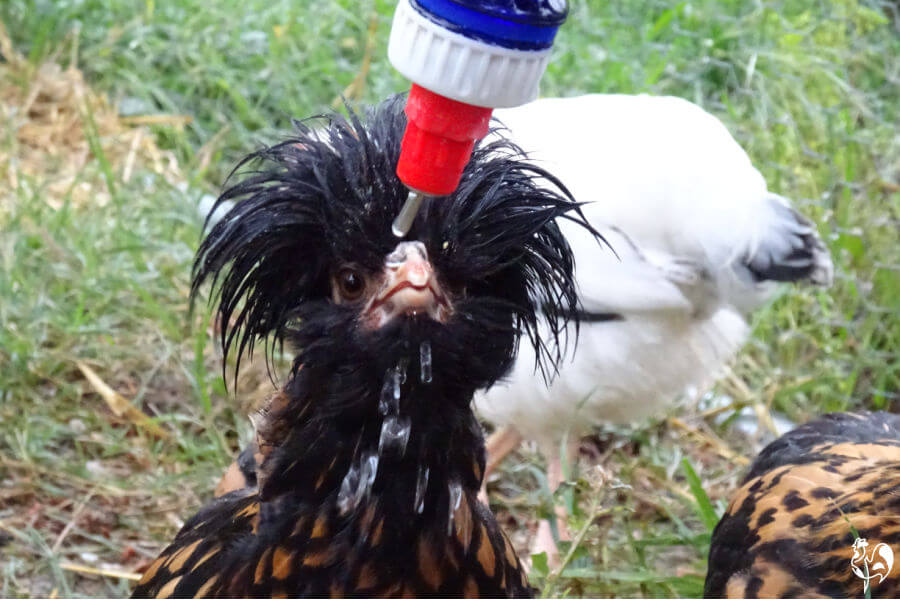 Offer food and liquid at different positions in the run, both on the ground and in hanging containers.
Offer food and liquid at different positions in the run, both on the ground and in hanging containers.5. Add "boredom busters" (known in the chicken industry as "environmental enrichment") to the run and coop to create more distractions. Find 25 different ways to prevent boredom, here and put some of them into action now!
6. Whatever you do, do not remove the victim(s) from the coop unless she has been physically injured.
Instead...
Isolating a relentless bully.
The time comes when the only option to stop chicken bullying is to remove the offender from the flock.
When is that time?
If, despite all your efforts, the bully is persistent to the extent of drawing blood, for example, or if the victim(s) are clearly miserable, then it's time to take decisive action – even if the offender is very young.
The earliest I've had to isolate was a two week old chick. He grew up to be a superb dominant guardian but needed teaching manners at that young age. He spent three days in a penned-off corner of the brooder and came out a different chick.
Using solitary confinement should be the last resort. It takes careful planning both to remove the offender and to reinstate him / her at the right time.
How to manage isolating a chicken: click this link for a detailed article.
And always remember: you cannot change the pecking order of a flock. You can simply deal with the problems if it becomes an issue of bullying.
If you found this article helpful, you'll enjoy these, too.
Sources.
A lot of "facts" you'll find on the internet are often people's individual views, based on inaccurate information repeated from poor quality sources.
The information I provide in this article and others is based not just on my own experience, but on evidenced facts from scientific, peer-reviewed research and books from highly respected and experienced poultry keepers such as Gail Damerow.
Some of the trusted sources I have used in this article are these.
1. Schjelderup-Ebbe, T: Social behavior of birds. Pub. A handbook of social psychology, Clark University Press, 1935.
2. Scarf, Damian: Pecking Order. Pub. Encyclopedia of Animal Cognition and Behavior, 2019.
3. Jacob, Dr. J: Normal behaviors of chickens in small and backyard poultry flocks. Pub. University of Kentucky, 2020.
4. University of Cincinnati. Unlocking the mysteries of the pecking order. Pub. ScienceDaily, 2022.
5. Strauss, Eli, et al: The centennial of the pecking order: current state and future prospects for the study of dominance hierarchies. Pub. The Royal Society, Biological Sciences, 2022.
6. Schjelderup-Ebbe, T: Contributions to the social psychology of the domestic chicken. Pub. Dowden, Hutchison and Ross, 1975.
- Home
- Challenges
- Pecking order
